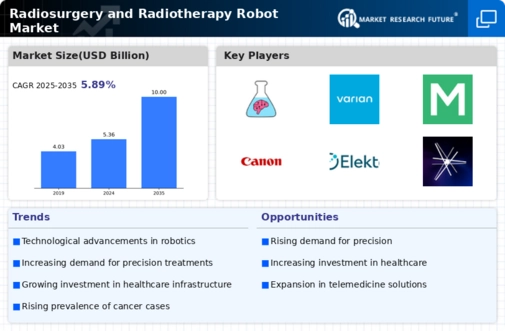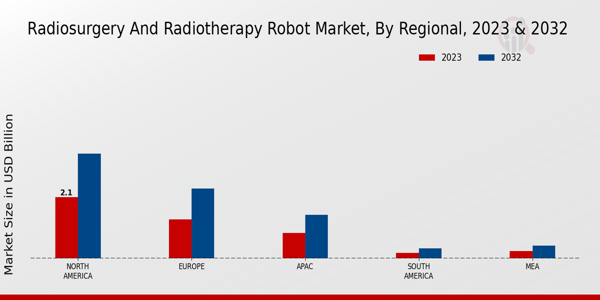Market Growth Projections
The Global Radiosurgery and Radiotherapy Robot Market Industry is poised for substantial growth, with projections indicating a market value of 5.36 USD Billion in 2024 and an anticipated increase to 10.0 USD Billion by 2035. This growth trajectory suggests a compound annual growth rate (CAGR) of 5.88% from 2025 to 2035. Factors contributing to this growth include technological advancements, increasing cancer incidence, and rising healthcare investments. As healthcare providers continue to seek innovative solutions for cancer treatment, the demand for radiosurgery and radiotherapy robots is expected to rise significantly, reflecting the industry's potential to transform cancer care on a global scale.
Technological Advancements
The Global Radiosurgery and Radiotherapy Robot Market Industry is experiencing rapid technological advancements that enhance treatment precision and patient outcomes. Innovations such as real-time imaging and adaptive radiation therapy are becoming increasingly prevalent. For instance, the integration of artificial intelligence in treatment planning helps in personalizing therapies based on individual patient data. These advancements not only improve the efficacy of treatments but also reduce side effects, thereby attracting more healthcare facilities to adopt these technologies. As a result, the market is projected to grow from 5.36 USD Billion in 2024 to 10.0 USD Billion by 2035, indicating a robust demand for sophisticated radiotherapy solutions.
Increasing Cancer Incidence
The rising incidence of cancer globally serves as a significant driver for the Global Radiosurgery and Radiotherapy Robot Market Industry. According to the World Health Organization, cancer cases are expected to rise by 70 percent over the next two decades. This alarming trend necessitates the adoption of advanced treatment modalities, including radiosurgery and radiotherapy robots, to manage the increasing patient load effectively. Healthcare providers are increasingly investing in these technologies to enhance treatment capabilities and improve patient outcomes. Consequently, the market is likely to witness substantial growth, with a projected CAGR of 5.88% from 2025 to 2035, reflecting the urgent need for innovative cancer treatment solutions.
Rising Geriatric Population
The growing geriatric population worldwide is a pivotal factor influencing the Global Radiosurgery and Radiotherapy Robot Market Industry. Older adults are more susceptible to various types of cancer, necessitating effective treatment options. As the global population aged 65 and above continues to rise, healthcare systems are increasingly adopting advanced radiotherapy technologies to cater to this demographic. This trend is further supported by the increasing awareness of the benefits of radiosurgery and radiotherapy among older patients and their families. Consequently, the market is likely to experience significant growth, driven by the demand for specialized cancer treatments tailored to the needs of the elderly.
Government Initiatives and Funding
Government initiatives and funding play a crucial role in propelling the Global Radiosurgery and Radiotherapy Robot Market Industry forward. Various governments are increasingly recognizing the importance of advanced cancer treatment technologies and are providing financial support for research and development. For example, grants and subsidies are being allocated to healthcare institutions to facilitate the acquisition of cutting-edge radiotherapy equipment. These initiatives not only enhance the accessibility of advanced treatment options but also stimulate market growth. As a result, the market is expected to expand significantly, with projections indicating a growth trajectory from 5.36 USD Billion in 2024 to 10.0 USD Billion by 2035.
Emerging Markets and Healthcare Infrastructure
Emerging markets are becoming increasingly important in the Global Radiosurgery and Radiotherapy Robot Market Industry due to their expanding healthcare infrastructure. Countries in regions such as Asia-Pacific and Latin America are witnessing significant investments in healthcare facilities, leading to improved access to advanced cancer treatment technologies. As these nations enhance their healthcare systems, the demand for radiosurgery and radiotherapy robots is expected to rise. This trend is further supported by the increasing prevalence of cancer in these regions, prompting healthcare providers to adopt innovative treatment modalities. The market's growth in these emerging economies is anticipated to contribute to the overall expansion of the industry.













